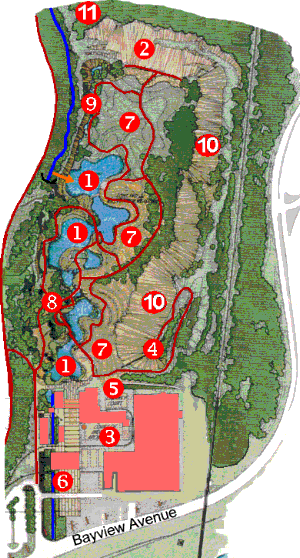This Park, which was acquired for public open space in 1990, has three themes: Water Quality Improvement in a Parkland Setting, Pleistocene Geology and The Brick Making Industry.
Return to Moore Park Ravine Reach
The Restoration began in 1995 with the creation of a dynamic wetland habitat, to portray the regeneration process. At the Don Valley Brick Works Park, the normal flow of Mud Creek is diverted into the Park to flow through a series of ponds (1) where the water is cleaned naturally before being returned to the Don River. A community of Carolinian trees and plants (8) is being encouraged on the west side of the quarry and a large wildflower meadow (7) has been started in the central area. Other plant communities are also being encouraged. A series of boardwalks and paths were constructed through the wetland and terrestrial environments.

The North Slope (2) of the old Brick Works quarry is recognized internationally for its Pleistocene geology. Excavation of this quarry exposed a series of glacial and fossil deposits that demonstrated that there was more than one major ice advance. Much of this slope appears to have stabilised close to its angle of repose and is becoming vegetated with a cover or shrubs and tree saplings. As it is to be maintained for geological education, research and heritage interpretation; active management to encourage vegetation communities is not planned.
A Lookout (4) has been established at the top of the east slope where the Bricks Works Site and the surrounding panorama can be observed.
The volunteer efforts of groups such as the Task Force to Bring Back the Don, Friends of the Valley, Friends of the Don East, The Garden Club of Toronto and the Evergreen Foundation as well as many local citizens, have contributed significantly to the vision and to the realization of this park and continue to provide significant support.
The Historic Buildings (3) at the south end of this site have been preserved to illustrate the former industry. They represent several different time periods in the history of the Brick Works.
As manufacturing processes were improved over the years, the use of the buildings changed, and new buildings were added to improve or replace the old ones. What has been preserved is a representation of the types of building and industrial machinery which were typical of a major Canadian brick manufacturing business. It is hoped that eventually a small museum will be established to interpret brick making, one of the significant industries in Toronto’s history. It was possible to keep only one of the four chimneys (5) that once served this plant.
In 1882, 25 year old William Taylor tested clay from digging fence post holes, and by 1889 he and his two brothers opened this brickyard that was to become pre-eminent in Canada. Their Don Valley Brick Works used rock and clay extracted from the quarry and water from Mud Creek to manufacture much of the bricks used to build Toronto. Buildings such as Casa Loma, Massey Hall, the Ontario Legislature, University of Toronto buildings such as Hart House and Convocation Hall and many homes throughout the city, were constructed using bricks from the Don Valley Brick Works.
From its beginning in 1889 as a soft-mud brick plant using glacial clays, its managers continuously experimented and improved processing methods here until brick production stopped one hundred years later, in January 1989. The consequence was regular upgrading and replacement of equipment. Successful experiments in 1890 on the use of shale for making pressed brick brought about an immediate major plant expansion and the opening of the shale quarry. Different methods of handling the harder shale and the softer, less consolidated clays and sands, were implemented over the years. Among the various products of the Brick Works were: stiff-mud bricks, dry-press bricks, sand-lime bricks, decorative terracotta tiles and structural pieces. A wide variety was available, ten shades of red, seven shades of buff, plus olive gold, brown obsidian and mottled. It was the first, and for many years the only plant in Canada, to make glazed (enamelled) bricks and the first to install arch grinding machines to supply brick ground to order for flat, elliptical or circular arches. Their exhibit of pressed brick won the highest award at the World’s Columbian Exposition at Chicago in 1893, and they won two gold medals for their exhibit of brick and terracotta at the Toronto Industrial Fair of l894. This plant produced a wider variety of bricks and kiln fired clay products than any other brick plant in Ontario. Daily production increased from 44,000 bricks in 1891 to 120,000 by 1912. It is of interest to note that the while the buff coloured glacial clays produced yellow bricks, the blue shale produced red bricks. See picture of Brick Works Quarry in 1977 when still in operation.
For more information on brick making see Brick Manufacture.
